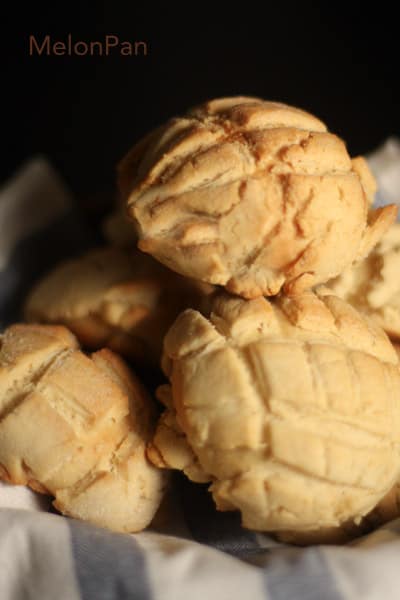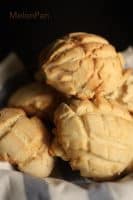
Just like there is no egg in eggplant, there is no melon in melonpan. Who would’ve thunk! As per the various blogs on the www, This much loved Japanese bread gets its name from the characteristic crosshatch shape the Japanese cut a melon in before serving. Here is a cute kiddie song that says there is anko (adzuki beans) in Anpan, Curry in Karepan but the melonpans don’t have any melons.
So what is a Melonpan? A type of Japanese sweet bread. The bread is a soft bun encased in a Pâte sablee . The delicate cookie-like crust, is moulded on top of the dough rolls. Since the Pate Sablee is fragile, the dough is simply pressed down into a circle and then wrapped on to the dough balls and the base of the dough left uncovered so that the dough can expand while baking. The top is then scored in a crosshatch pattern to represent the Japanese way of cutting and serving a melon. When the baking process completes, the top of the bread looks a bit crackly, just like a cantaloupe.

It is interesting to note that the name Melonpan is not of Japanese origin but rather a combination of the English word melon and the Portuguese word pan, meaning bread. The bread is popular throughout Japan.
The bread dough is typically made with flour, yeast, and sugar. These ingredients are mixed with butter, salt, and milk powder. The pastry layer includes butter, sugar, and eggs mixed with cake flour and baking powder.

Since my in laws are visiting and they are vegetarians, I could not use eggs to bake this bread which is part of the “We Knead to Bake” hosted by Aparna. I ended up changing the recipe a bit to make it eggless.
I made an egg replacer with flax seeds and put that into the bread and the pate sablee. The resulting bread tasted great, baked wonderfully and was moist with a good mouthfeel. I do feel that if I had used eggs, the resulting melonpans would have gotten a better oven spring. But nevertheless these were great!

Melonpan – Cookie Covered Bread Rolls
Ingredients
Bread Dough
- 1 3/4 cups all-purpose flour
- 2 tbsp milk powder
- 1 tsp instant yeast
- 1/2 tsp salt
- 1/3 cup cold milk
- 45 ml flax seed egg replacer
- 1 tbsp sugar
- 25 gm butter at room temperature
For cookie dough:
- 1 1/3 cups cake flour
- 3/4 teaspoon baking powder
- A large pinch of salt
- 60 gm butter at room temperature
- 1/3 cup powdered sugar
- 45 ml flax seed egg replacer
- 1/2 teaspoon vanilla extract
- 1 teaspoon lemon zest
Sugar for dusting
Instructions
Make the bread dough
- Whisk together the flour, powdered milk, yeast, and salt in the bowl of a stand mixer. Mix the flax seed egg replacer and milk together until thoroughly blended. Add this liquid to the flour mixture in the bowl.
- Using the dough hook, mix at low speed until the dough comes together. Once the dough comes together, Increase the speed, and mix at medium speed for about 3-4 minutes.
- Slowly add the sugar.You will need to reduce the speed before adding this in. Mix until the sugar is fully incorporated. The dough will soften a little at this point. Increase the speed to medium, and knead the dough until it is glossy and supple.
- Now add the softened butter. Knead until mixed in, 2 or 3 minutes. Ensure the butter is fully incorporated into the dough.
- Transfer the dough to a lightly-oiled bowl, and cover tightly with plastic wrap. Let sit at room temperature until doubled in size, about 1 hour.
Make the cookie dough
- Whisk together the flour, baking powder, and salt; set aside. In the bowl of a stand mixer, using the paddle attachment, cream together the butter and sugar at medium-high speed until fluffy, about 2 minutes, scraping the bowl as necessary. Add the flax seed egg replacer and vanilla, and beat until combined.
- Gradually add the flour mixture to the butter and sugar mixture, mixing at low speed just until combined. Wrap the dough tightly in plastic wrap, and refrigerate while waiting for the dough to finish its rise.
- Lightly grease a large baking sheet, or line with parchment paper. Turn the dough out onto a lightly floured surface, and gently deflate. Divide the dough evenly into 8 pieces. Round each piece into a ball, and transfer to the prepared baking sheet.
- Cover the dough balls loosely with lightly-oiled plastic wrap, and let sit at room temperature while you get the cookie covers ready.
- Unwrap the cookie dough, and divide it into 8 even pieces. Roll each into a ball, keeping unused pieces covered. Press each ball into a flat circle about, about 3 1/2 inches in diameter.
- Drape each piece of cookie dough over the bread dough, being careful not to deflate the rising dough. The cookie dough should encase the top and sides, but not the bottom, of each roll. With a sharp paring knife, score each round with a crosshatch pattern.
- Preheat the oven to 350*F. Let the dough balls rise for about an hour and then bake for 25 minutes, or until barely golden brown on top. Transfer to a wire rack to cool. Eat the same day for the best taste and mouthfeel.

